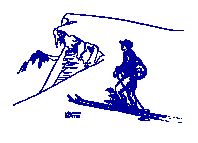Skiting combines two skills: piloting a traction kite while skiing with pack without poles. A power kite is not a toy.
![]() My NASA Wing 9 has a surface area of 3.4 square meters and can develop a pull of 150 lbs. Uncontrolled, it can propel a person to dangerous speeds and cause serious injuries. One has to steer it so as to match the pull to a safe speed. Steering occurs via two or four lines connected to handles. With these, one moves the kite horizontally and vertically out of the wind so as to limit the pull. Two of the four lines serve as breaking lines by changing the curvature of the wing. The lines are typically 75 feet long, lightweight but rated at 500 lbs. Kite and lines weigh only about a pound and can easily be stashed away in a backpack. I have ordered my kite from the web. Count on spending $100-200 for a basic setup.
My NASA Wing 9 has a surface area of 3.4 square meters and can develop a pull of 150 lbs. Uncontrolled, it can propel a person to dangerous speeds and cause serious injuries. One has to steer it so as to match the pull to a safe speed. Steering occurs via two or four lines connected to handles. With these, one moves the kite horizontally and vertically out of the wind so as to limit the pull. Two of the four lines serve as breaking lines by changing the curvature of the wing. The lines are typically 75 feet long, lightweight but rated at 500 lbs. Kite and lines weigh only about a pound and can easily be stashed away in a backpack. I have ordered my kite from the web. Count on spending $100-200 for a basic setup.
Here are my initial experiences: I started to practice without skis in flat terrain when the wind is moderate.
![]() Stay away from people, trees, power lines, etc, since one has to count on occasional crashes or loosing the kite. A second person is helpful, but one has to learn solo starting the kite.
Stay away from people, trees, power lines, etc, since one has to count on occasional crashes or loosing the kite. A second person is helpful, but one has to learn solo starting the kite.
![]() The conditions were favorable, the kite pulled nicely and I got a pleasant ride. At times it became too fast and I had to brake. Of course nothing is perfect: The snow was wind blown crust and the kite was right in the sun. It requires some mental effort (or practice) to control hands and feet separately. But that is part of the challenge of skiting.
The conditions were favorable, the kite pulled nicely and I got a pleasant ride. At times it became too fast and I had to brake. Of course nothing is perfect: The snow was wind blown crust and the kite was right in the sun. It requires some mental effort (or practice) to control hands and feet separately. But that is part of the challenge of skiting.
![]() The falls are outweighed by the pleasure of gliding with the wind. It's a thousand times better than being pulled by a noisy, smelly snow mobile or a bunch of barking dogs.
The falls are outweighed by the pleasure of gliding with the wind. It's a thousand times better than being pulled by a noisy, smelly snow mobile or a bunch of barking dogs.
What are the long range plans? Having once skied 50 mi in the White Mountain Range I am thinking of better ways to do that again: Skiting from Westgard Pass to Boundary Peak. The terrain is open, gentle and there is always a breeze. Of course, it has to be done when snow, weather and wind directions are favorable. Most importantly, it requires a group of people with comparable skills. Thus, I am hoping to entice some other SMS members to try the fun of skiting. New toys open up new adventures. Let's do some pioneering ski trips with kites.
Back to Trip Reports
Back to SMS Home Page
